
 |
||
| by Delfina de Araujo | ||
| Since
the first artificial hybrid (done in 1853 and registered in l856), a Calanthe
(*), bloomed, the man has never stopped in his purpose of playing the part
of the Creator. The result of this search is more than 100.000 artificial hybrids registered and this number increases every year due to the high degree of compatibility between different species or even different genera. The primary hybrids are result of the cross between two species of the same genus or different genera since they are compatible between them. The process is simple: The pollen of a flower is put into the stigma of another flower, if the fecundation is well succeeded, soon after the ovary starts to swell and months later (time of maturation depends on the genus and on the species), the pod became matured and delicate seeds (sometimes millions of them), looking like powder should be put in a nutrient solution to allow suitable conditions to germinate. The plants thus obtained can be successively re-crossed with one of the species involved or another species or even with another hybrids in an arithmetical infinite proportion. The hybrids are registered at the Royal Horticultural Society (The International Registration Authority for Orchid Hybrids), so, in this way, at any time, we can follow the tracts of every species involved , even though it is a complex hybrid of many generations. The hybrid has also two names (like the natural species), however the second name is no presented in italic nor latinized. In crosses of species of the same genus, the name of the genus does not change, for example, Cattleya guttata and Cattleya aurantiaca, which gives Cattleya Chocolate Drop. |
|
+
|
|
=
|
|
|
When
the cross involves species of different genera, such as Brassavola
X Laelia, for example, the name is modified and the genera obtained
is named Brassolaelia. The Brassolaelia Morning Glory, for
example, is the result of crossing Brassavola nodosa X Laelia
purpurata.
The doubt remains. Why do hybrids? Let us put aside all those commercial points of view, all those divagations and let us enjoy the work of two hybridizers who stand out in Brazil. The
first one in the past (although recent) and the second, in the present: and
Bibliography: |
ON: Roberto, you have recently registered approximately 100 hybrids of Cattleya almost creating a dynasty to which you gave the name of Samba tothe big part of them. The results are coming out and one of the seedlings, a Slc. Samba Princess, blooming for the first time, deserved a HCC/AOS, in 2000, in São Paulo Orchid Show. In order to give us an idea of how works the hybridization procedure, could you tell us what was your purpose when you crossed Blc. Williette Wong with Blc. Toshie Aokie 'Pizzaz' to do Blc. Hans Kunning? ROBERTO: I wanted to get a plant very close to Blc. Toshie Aoki, without being Blc. Toshie Aoki itself and inject a new blood. In order to give a new strengh to the growth, I used Blc. Williette Wong, which is 50% Blc. Toshie Aoki and cross it again with Blc. Toshie Aoki. |
| What
happened? The plants grow easier, bloom all year round and they go on with
yellow and red lip, as I intended to do. In some plants, the red is almost
a velvet and in some, there are those two yellow eyes that remind the influence
of Cattleya dowiana var. aurea which has those two wonderful
yellow eyes in the throat. It is simple like that, I just wanted to go on
with this llineage yellow e red but with a plant more vigorous than Blc.
Toshie Aoki without losing the color and the shape of its flowers. Those
plants blooming during the summer (January, February and March, in south
hemisphere) when you don't have so many varieties of Cattleya and
enduring the heat, which is a very important quality. We cultivate those plants in Guapimirim where the heat is fantastic, such last year when we had 10 days, with 40, 42 º C, every day, inside the greenhouses. |
|
| The
plant endures well this heat, blooms, the flower opens and gets firmly under
this heat without withering.
This is more or less the way I could find inside the place I cultivate. ON: And this was your aim when you did those crosses ... ROBERTO: This is my aim, always trying to facilitate, always looking for an easier plant to be cultivated with a wonderful flower. ON: And blooming in different season of the year... ROBERTO: Yes, I have a variety of blooming seasons, the plants don't bloom at the same time. I admit that I like sowing seeds because it gives a wide possibilities range. I like to play with the plants. Of course, I do not get any plant to cross with any plant, first I try to ivestigate and see what had worked and what had not. It is no use to think that I will cross this yellow with this purple and get all those imaginary colors. If you are using a recessive plant with a super-dominant plant, you will have just a color. I think that if you work a little you can succeed in making a cross that will give a wide range even regarding to blooming season, for example. ON: You said that the sowing seed gives a wide varieties range, however , if you just use plants with the characteristic of Cattleya aurea or dowiana var. aurea, as you wish (small yellow yes) in the cross, even so, there is a risk to get a flat flower, without this characteristic (yellow eys)? ROBERTO: No, if you use two plants with this characteristic, of course, you are strengthen the two yellow eyes. ON: So if you cross it again, it will bring this characteristic? ROBERTO: For example, the Blc. Williette Wong had those two eyes and the Blc. Toshie Aoki had an entirely red lip. So you will have a division in the progeny, a percentage will have those yellow eyes and another, doesn't. The same thing happens to Blc. Samba Eyes (provisory register), which has Cattleya intermedia var. aquini in two generations before. What happens? Thirty per cent of those plants will be flamed. The name Samba Eyes is because it reminds two eyes, the petals are marked... |
|
ON:
It looks like a mask. ROBERTO: Exactly, it seems to be a mask, however this is n illustrative photo, it is the best I obtained, some of them will not be so well defined and some will not have the aquinoid. That's why I think it is funny cultivate from sowing seeds. If you buy a meristem, you look at the photo and you know that the plant will exactly like the photo. I like to buy a lot of 50 seedlings of a cross because you can have from the most fantastic things until a thing that brings you to think: "- It is unbelievable that so much wonderful matrixes can result in such a rubbish". It happens and happens with everyone. |
| ON:
And Potinara Samba Passion?
ROBERTO:
I got a plant called Slc. Orient Amber 'Florida' which is orange
and cross with Bc. Pastoral that blooms for Mother's Day. I wanted
a soft colored plant, blooming at Mother's Day and I finished for getting
a plant that blooms all year rond. ON: The colors are very soft. |
|
| ROBERTO:
I liked the result very much and that is another way to be investigated.
I did a series of plants which I call pink such Bc. Samba Sensation. I got a Bc. Turandot 'Guaxupé', using a good Brazilian plant and crossed it with Bc. Pink Sensation. The flower is interely pinkish with a touch of yellow in the lip. I like those soft colors too. I think it is wonderful when you have a well defined color. I hate dirty colors in orchids, many times, you look and ask to your self: "- What color is this?" You can't define it very well. If you have a pastel-color, it should not be a mixture of different colors, you should know exactly what color is it, you should be able to identify the color and not stay wondering: "- Is this orange, or it is dirty yellow or it is brown mixed with yellow?" |
|
|
I
don't want this. I want that the person identifys, this plant is passion-fruit
color, milk shake of raspberry, it should have a defined, an identifiable
color. |
|
For
example, my next way is already done, it is Bc. Samba Sensation
crossed with Slc. Samba Princess, going on with producing pure pink flowers with yellow lip. I am antecipating what will be my next generation. |
| ON:
And Blc. Samba Saga?
ROBERTO:
One of the parents, Lc. S. J. Bracey, had aldready this color or
similar, however it was not so accentuated, there was already this red
edge, those filigrees around, it has been crossed with Blc. Saga
which flowers are entirely yellow, however they also have an intense red.
|
|
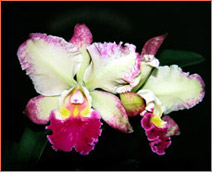 C. Samba E lf |
ON:
Which is the cross of C. Samba Elf ?
ROBERTO:
It is a cross of C. aclandiae and C. Enid 'Butterfly' and
the firsts seedlings carry medium size flowers. |
|
ON: And what about Potinara Samba Laranja? ROBERTO: It has elongated stem carrying up to 5 oragen wonderful flowers. |
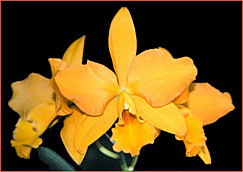 Pot.
Samba Laranja Pot.
Samba Laranja |
| ON:
Can you change the color and the shape, when you did a hybrid? ROBERTO: No, when make a I cross, I do not change the color nor the shape. I choose two plants assuming they will bring me a certain result however there is no manipulation in the cross. You make a cross thinking that the flowers will be in a color or in a certain shape, etc. You should know how choosing well your suas matrixes to get the result you look for. |
|
Hybrids
by Roberto Agnes/Aranda
|
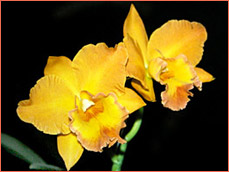 |
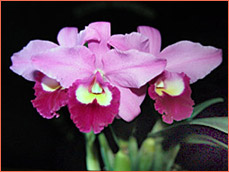 |
||
|
Pot.
(Twenty
Four Carat x Blc. Olmec Treasure)
|
Lc.
Samba
Crown
|
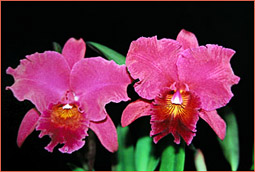 |
|||
|
Pot.
Samba Jewel
|
|
Any
kind of reproduction (print, digital or anyone other) of any type of
material of this
site - texts, lay-out, photos, images and others - is strictly forbidden without the previous written permission of the authors. Any solicitation or information should be done by the e-mailbo@sergioaraujo.com |